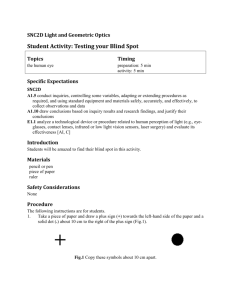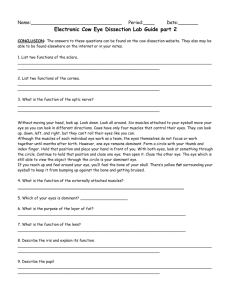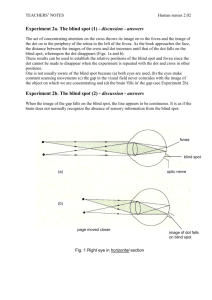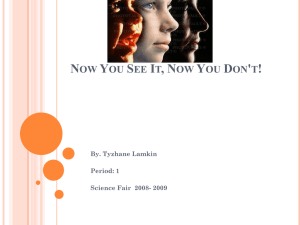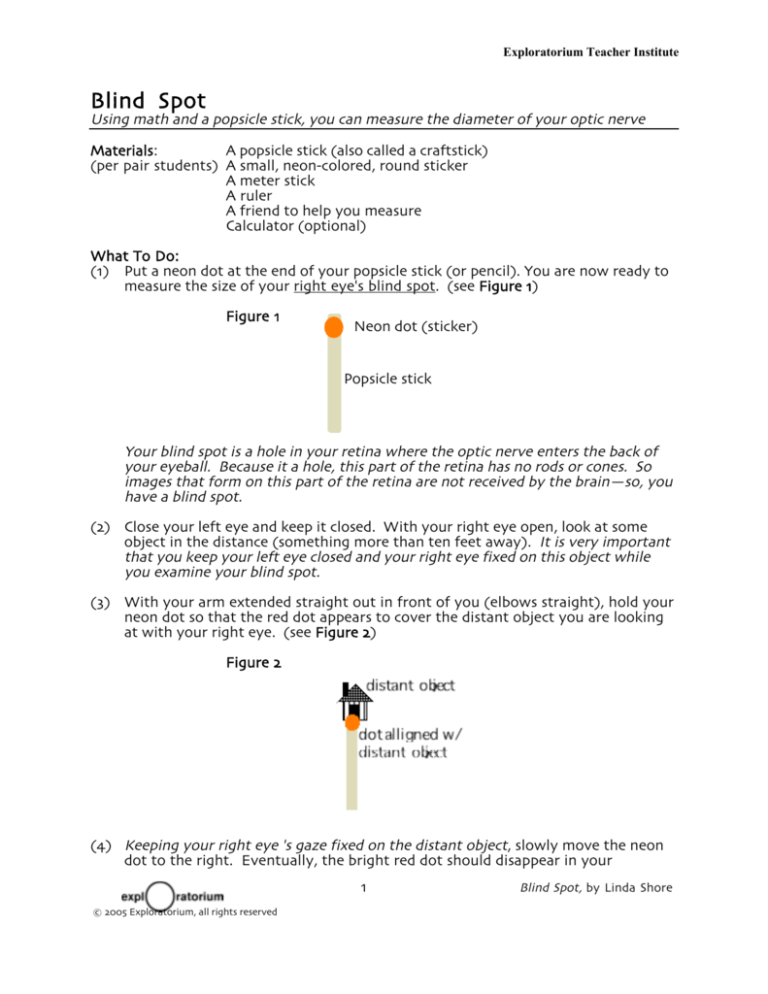
Exploratorium Teacher Institute
Blind Spot
Using math and a popsicle stick, you can measure the diameter of your optic nerve
Materials:
A popsicle stick (also called a craftstick)
(per pair students) A small, neon-colored, round sticker
A meter stick
A ruler
A friend to help you measure
Calculator (optional)
What To Do:
(1) Put a neon dot at the end of your popsicle stick (or pencil). You are now ready to
measure the size of your right eye's blind spot. (see Figure 1)
Figure 1
Neon dot (sticker)
Popsicle stick
Your blind spot is a hole in your retina where the optic nerve enters the back of
your eyeball. Because it a hole, this part of the retina has no rods or cones. So
images that form on this part of the retina are not received by the brain—so, you
have a blind spot.
(2) Close your left eye and keep it closed. With your right eye open, look at some
object in the distance (something more than ten feet away). It is very important
that you keep your left eye closed and your right eye fixed on this object while
you examine your blind spot.
(3) With your arm extended straight out in front of you (elbows straight), hold your
neon dot so that the red dot appears to cover the distant object you are looking
at with your right eye. (see Figure 2)
Figure 2
(4) Keeping your right eye 's gaze fixed on the distant object, slowly move the neon
dot to the right. Eventually, the bright red dot should disappear in your
1
© 2005 Exploratorium, all rights reserved
Blind Spot, by Linda Shore
Exploratorium Teacher Institute
peripheral vision. If you have moved the red dot more than about 20° from its
position straight out in front of you, you have gone too far.
(5)
When you find the location of the spot where the red dot disappears, move the
dot up and down. Remember to keep your right eye focused on the distant
object straight in front of you and keep your arm straight with your elbows
locked! How high is your blind spot when the dot is held out at arm's length?
Using a ruler, have a friend help you measure the height (H) of your blind spot.
(see Figure 4)
Dot appears to
vanish here for
the right eye
View from top of
your head
Left side
of head
Right side
of head
Height of
bl indspot
(6)
Collect the following measurements:
Figure 4
H = The height of your blind spot (in cm)
D = The distance from your eye to the stick (in cm)
Here is a measurement you’ll need:
d = The diameter of your eyeball = 2 cm
(7)
With this data you are ready to estimate the size of your optic nerve. You’ll use
the geometry and mathematics of similar triangles to make this estimate.
Figure 5 below shows the relationship between the sides for triangles that are
similar. Because light travels in a straight line from objects to your retina, we
can make use of these same relationships to find the size of any image on the
back of your eye (the retina). Figure 5 also shows a ray diagram that
demonstrates how the size of any object and the size of its image can be found
by applying the knowledge that the ratio of the length and height of similar
triangles are equal.
2
© 2005 Exploratorium, all rights reserved
Blind Spot, by Linda Shore
Exploratorium Teacher Institute
Figure 5
H
h
d
D
h
D
d
H
D/H = d/h
3
© 2005 Exploratorium, all rights reserved
Blind Spot, by Linda Shore
Exploratorium Teacher Institute
Figure 6 shows the relationship between the height where the dot appears to vanish
(H), the distance between the eye and the stick (D), the diameter of the eyeball (d),
and the unknown that you need to solve (the size of the optic nerve or hole in your
retina, or h). This calculation will give you the diameter of your optic nerve – the size of
the hole in the back of your eye. The formula you will use is:
h = d (H/D)
Figure 6
Height of your
“blind spot”
(H)
Diameter of the
Eyeball (d)
Distance To The
Popsicle Stick (D)
Size of the
Optic Nerve
(h)
Optic Nerve
How Did You Do?
The diameter of your optic nerve is about 2-3 mm. How did your estimate compare?
4
© 2005 Exploratorium, all rights reserved
Blind Spot, by Linda Shore

